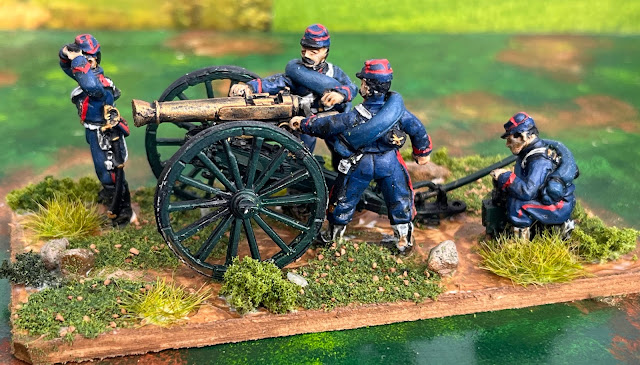I have discussed the mitrailleuse before on these pages and expressed my view that it was a largely failed
concept and should be described as a volley gun rather than a machine gun, but it was still an important part of the French arsenal in 1870, if only because it made up one third of the divisional artillery in the Imperial army.
In short the mitrailleuse was a collection of 25 rifle barrels arranged in five rows and encased within a brass cylindrical casing. On the turn of a handle it fired each row in a sequence of barrels left to right (in direction of fire) 1,4,2,5,3. It fired 13mm bullets in a metal cartridge with a substantial powder charge that gave it an extremely high muzzle velocity for the time, nearly a three times that of the Chassepôt and five times that of the Needle Gun, which gave it tremendous hitting power even at ranges as far out as 2000 meters. With an almost flat trajectory out to 500 meters it had a good depth of fire, but an extremely narrow spread of shot that even at 2000 meters range was a maximum spread of 15 metres. This lack of spread was one of the mitrailleuse's greatest weaknesses. It was also extremely difficult to range the weapon because without an explosive round the only way to judge the range was to observe the damage to the target or to watch for the dust thrown up when it hit the ground. Both of these ranging techniques were difficult at extended ranges, especially through the smoke generated when it fired. In fact in two of the opening battles, Froeschwiller and Spicheren, it rained heavily the night before and there was no dust the throw up.
Perhaps the biggest inhibitor to success was that the weapon had been developed in secrecy and the operating crew had to be trained in its use in the field. Despite the secrecy the Germans had a pretty good knowledge of its existence and capabilities and were sufficiently wary of it to target it early in the action. At Wissembourg the mitrailleuse battery was caught in a crossfire between three German batteries from the moment it opened fire with catastrophic results - one of the ammunition carts was hit and a large number of crew were casualties, causing the battery to retire from action. That same explosion killed General Douay, commanding the division. Two days later the mitrailleuse battery in action on the Rothenburg near Spicheren was targeted by four German batteries and forced back with two weapons temporarily dismounted.
That said, mitrailleuse did have its successes and there were numerous diary entries from German soldiers that spoke of its effectiveness. The most notable casualty of the weapon was General von François who was struck by five mitrailleuse bullets while leading a charge up the Rotherburg at Spicheren.
For anyone who has an interest in the technical aspects of this weapon, this YouTube video may be of interest and you might want to check out Steve Shann's new book on the subject here.
Below is the first of what will be three mitrailleuse batteries in my FPW army.
 |
| The officer trying to observe the fall of shot... |
And here is the divisional artillery for Vergé's Division - two field and one mitrailleuse battery.
So with three posts in three days on French artillery that's enough about guns for now and I will move on to a new subject...at least for a week and a bit.





Superb result, Mark. I have always wondered if the role of this weapon was mis-tasked Rather than positioned with artillery in battery, would this weapon have been more effective in an infantry close support role?
ReplyDeleteIt was a nice set to work with. Since Louis Napoleon was an artillery aficionado it was developed from the outset as artillery and I doubt if military thinkers of the 1860s even understood the concept of infantry close support - most considered canister adequate infantry close support. I think that the sheer weight of the mechanism precluded its use in the forward line.
DeleteAnother excellent unit and an informative post Mark…
ReplyDeleteI’ve always had the feeling that the French didn’t really know how they wanted to use this weapon…
All the best. Aly
And I think the secrecy of its development, combined with Napoleon III's artillery obsession led to that lack of understanding. The ack of practical training combined with the fact that the Imperial Army was either bottled up or forced into captivity after a month of active operations meant that they never had a chance to find a use for it. After the initial fumbling in the opening battles they did learn its uses and employed it with some effect at Borny and Gravelotte-St Privat.
DeleteHaving to learn how to use it in the heat of battle seems to me the biggest drawback. You would think some of the other disadvantages might have been overcome with more training. Another lovely model Mark.
ReplyDeleteYou can almost imagine the conversation amongst the crew.."so where does this but go?"
DeleteFine units once again Mark:). Nice background info too and sad that the French hadn't quite figured out how to best use it in battle.
ReplyDeleteThanks Steve. The poor French gunners weren't really given much of a chance when you think of it...and they considered themselves the master of the arm.
DeleteNice to see these. When you come to do more artillery, it strikes me that a lot of the crew figures can be swopped around to increase the variety. Obviously not the chap working at the mitrailleuse "reloading table"!
ReplyDeleteYes I am planning that for the next batch of three gun sets. Also when the next order is placed I will include a couple of 12lb gun sets that will provide some additional variation. I also have the Prussian heavy guns in the painting queue.
Delete